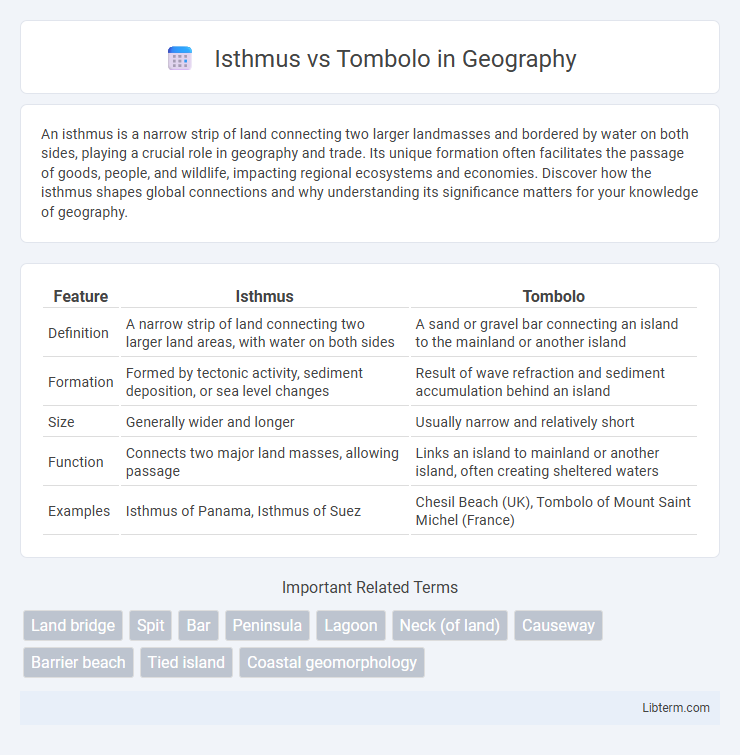An isthmus is a narrow strip of land connecting two larger landmasses and bordered by water on both sides, playing a crucial role in geography and trade. Its unique formation often facilitates the passage of goods, people, and wildlife, impacting regional ecosystems and economies. Discover how the isthmus shapes global connections and why understanding its significance matters for your knowledge of geography.
Table of Comparison
| Feature | Isthmus | Tombolo |
|---|---|---|
| Definition | A narrow strip of land connecting two larger land areas, with water on both sides | A sand or gravel bar connecting an island to the mainland or another island |
| Formation | Formed by tectonic activity, sediment deposition, or sea level changes | Result of wave refraction and sediment accumulation behind an island |
| Size | Generally wider and longer | Usually narrow and relatively short |
| Function | Connects two major land masses, allowing passage | Links an island to mainland or another island, often creating sheltered waters |
| Examples | Isthmus of Panama, Isthmus of Suez | Chesil Beach (UK), Tombolo of Mount Saint Michel (France) |
Definition of Isthmus
An isthmus is a narrow strip of land connecting two larger landmasses, typically bordered by water on both sides, facilitating land-based passage. In contrast, a tombolo is a sand or sediment bar that connects an island to the mainland or another island, often formed by wave action and sediment deposition. The key defining feature of an isthmus lies in its function as a natural land bridge between substantial land areas.
Definition of Tombolo
A tombolo is a coastal landform where a sand or sediment bar connects an island to the mainland or another island, formed by wave refraction and deposition. Unlike an isthmus, which is a narrow strip of land naturally connecting two larger land masses, a tombolo specifically results from sediment accumulation creating a natural bridge over water. The formation of tombolos is influenced by wave patterns, currents, and sediment supply in coastal environments.
Key Differences Between Isthmus and Tombolo
An isthmus is a narrow strip of land connecting two larger landmasses, typically bordered by water on both sides, while a tombolo is a sand or sedimentary landform that connects an island to the mainland or another island through deposition. Isthmuses serve as critical land bridges facilitating terrestrial migration and human transportation, whereas tombolos form primarily through wave refraction and sediment accumulation processes. The key differences lie in their formation mechanisms, physical structure, and ecological importance, with isthmuses often being broader and older geological features compared to the usually narrower and younger tombolos.
Formation Processes: Isthmus vs Tombolo
An isthmus forms through sediment deposition or tectonic activity that connects two larger landmasses, often created by the accumulation of sand, gravel, or volcanic material in narrow coastal areas. A tombolo develops when wave refraction and diffraction converge sediment between an island and the mainland, resulting in a sand or gravel bar that links the two. Both landforms result from distinct sedimentary and hydrodynamic processes shaping coastal geography.
Notable Examples of Isthmuses Worldwide
The Isthmus of Panama serves as a crucial land bridge connecting North and South America, facilitating significant ecological and economic exchange. Another prominent example is the Isthmus of Suez in Egypt, linking Africa and Asia while hosting the vital Suez Canal for global maritime trade. The Isthmus of Corinth in Greece connects the Peloponnese peninsula to mainland Greece, showcasing its historical strategic importance in controlling naval routes.
Famous Tombolos Around the Globe
Famous tombolos such as Chesil Beach in England, Mount Maunganui in New Zealand, and St. Ninian's Isle in Scotland demonstrate unique landforms where sand or sediment connects an island to the mainland, contrasting with isthmuses that link larger landmasses. These natural sandbars create sheltered waters and distinct ecosystems, making them critical for biodiversity and coastal protection. Recognizing tombolos helps in understanding coastal geomorphology and managing tourism and environmental conservation efforts effectively.
Geographical Importance of Isthmus
An isthmus serves as a critical land bridge connecting two larger landmasses, facilitating trade, migration, and cultural exchange while influencing regional climate patterns. Unlike a tombolo, which links an island to the mainland or another island through a sedimentary spit, an isthmus often hosts strategic transportation routes and economic corridors vital for global connectivity. The geographical importance of isthmuses is exemplified by landmarks such as the Isthmus of Panama, where the Panama Canal revolutionized maritime navigation by bridging the Atlantic and Pacific Oceans.
Ecological Significance of Tombolo
A tombolo, a sand or gravel bar connecting an island to the mainland, creates unique ecological zones by forming sheltered areas that support diverse marine and coastal habitats. These landforms encourage the development of salt marshes, seagrass beds, and tidal pools, which are critical for breeding fish, migrating birds, and invertebrates. In contrast to isthmuses, tombolos enhance nutrient circulation and provide refuge from strong waves, contributing significantly to biodiversity and ecosystem stability in coastal environments.
Human Impact on Isthmuses and Tombolos
Human activities such as coastal development and construction of infrastructure significantly alter the natural dynamics of isthmuses and tombolos, leading to erosion and habitat loss. Urbanization and tourism increase sediment disruption and pollution, impacting the stability of these narrow landforms and the ecosystems they support. Conservation efforts and sustainable management practices are essential to mitigate human-induced degradation and preserve the ecological integrity of isthmuses and tombolos.
Summary: Comparing Isthmus and Tombolo
An isthmus is a narrow strip of land connecting two larger landmasses, typically formed by tectonic activity or sediment deposition, while a tombolo is a sand or gravel bar that connects an island to the mainland or another island, created by wave refraction and sediment accumulation. Isthmuses often serve as crucial land bridges for wildlife and humans, enabling transportation and migration, whereas tombolos influence coastal ecosystems and can modify tidal flows. Both landforms highlight dynamic interactions between land and water but differ in formation processes and geological significance.
Isthmus Infographic

 libterm.com
libterm.com